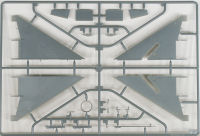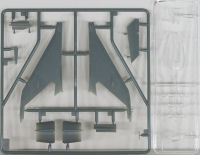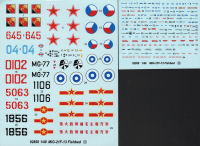
Trumpeter 1/48 MiG-21F-13 Fishbed E Kit First Look
By Michael Benolkin
| Date of Review | December 2012 | Manufacturer | Trumpeter |
|---|---|---|---|
| Subject | MiG-21F-13 Fishbed E | Scale | 1/48 |
| Kit Number | 2858 | Primary Media | Styrene, Photo-Etch |
| Pros | First good Gen 1 MiG-21 in 1/48 scale | Cons | Airframe stencils |
| Skill Level | Intermediate | MSRP (USD) | $41.95 |
First Look
 |
 |
 |
 |
 |
 |
The MiG-21 was MiG OKB's first production Mach 2-capable interceptor building upon the experience with their previous fighter designs. The MiG-21F (NATO Codename: Fishbed C) was the first production variant which was a day fighter that was equipped with a range-only radar in the centerbody intake radome to support the two NR-30 30mm cannons mounted under either side of the cockpit. The MiG-21F would become the first of the Generation One MiG-21s which are distinguishable by the small centerbody radome, the narrow-chord vertical stabilizer, and the distinctive one-piece canopy.
The canopy was actually part of the ejection system that allowed the pilot to eject whilst supersonic - as the seat fired and came up the rails, the sides of the seat would engage the rear of the canopy and as the seat continued up out of the aircraft, the canopy would come down to cover the pilot's body and protect him from the high-velocity air that would otherwise shred him. This system looked good on paper, but in practice was not so effective, so it was replaced with a different system starting with the MiG-21PFM Fishbed F.
The MiG-21F-13 (NATO Codename: Fishbed E) was the 'sport model' of the entire MiG-21 series as it was the lightest and most agile version. The F-13 version is distinctive with the port side NR-30 (and its ammo) are removed and the airframe is wired to support the K-13 (NATO Codename: AA-2 Atoll) heat-seeking missile, one carried under each wing.
Here's the first Generation One MiG-21 to be produced in plastic in 1/48 scale, this coming from Trumpeter and based upon their great 1/32 scale kit released a number of years ago. The kit is molded in gray styrene and presented on nine parts trees plus one tree of clear parts, one fret of photo-etched parts, and one set of rubber main gear tires. The kit isn't over-engineered and has some nice features and options:
- Nice supersonic ejection seat with photo-etched belts and harness
- Nicely detailed cockpit
- Correct armored windscreen
- Positionable canopy
- Correct main wheel wells
- Detailed afterburner chamber with odd turbine face design
- Positionable ailerons
- Positionable Fowler flaps
- Positionable rudder
- Stabilators can be made positionable
- Positionable ventral speed brakes
- Centerline fuel tank
- 2 x K-13 missiles
- 2 x RS-2US missiles (not used in this version)
- 2 x OFAB-250 bombs
- 2 x UB-16-57 rocket pods
Some of the parts like the canopy are not shown to be positionable but they are easily adapted into whatever position you would care to portray on your model.
The instructions show that the 2 RS-2US (NATO Codename: Alkali) missiles are used in this version but this is incorrect. The RS-2US was missile guided by following the radar beam of the launching aircraft (beam rider) and neither the MiG-21F nor MiG-21F-13 had intercept radars. The RS-2US was first used on the MiG-21PF Fishbed D which was the first all-weather MiG-21 and the first version with an intercept radar.
If you find the bombs and rocket pods out of place, as newer versions of the MiG-21 entered service, the older versions were usually reassigned to air-to-ground missions or exported to allied nations (who also used them for air-to-air and air-to-ground missions).
This kit provides two sheets of decals which provide six markings options:
- MiG-21F-13, Bort 04, Tushino AB, Soviet AF, 1961
- MiG-21F-13, Bort 0102, PLAAF
- MiG-21F-13, Bort 5063, North Vietnamese AF
- MiG-21F-13, Bort 645, East German AF
- MiG-21F-13, Bort 1106, Czech AF
- MiG-21F-13, Bort MG-77, Finnish AF
The first sheet provides the distinctive national markings while the second sheet provides airframe and weapons stencils. The stenciling looks like a close attempt to replicate Cyrillic airframe stencils but many of the stencils are either misspelled or gibberish. If you can read Cyrillic, you can use the MiG-21 Family stencil set released by Begemot Decals. One subject I'm rather surprised that is not on this sheet is the infamous 007, the MiG-21F-13 that was captured and flown by the Israeli Air Force for test and evaluation.
This is a nice looking kit that fills a major gap in the MiG-21 family. WIth the release of Eduard's outstanding Gen 3 1/48 MiG-21s, we've only had the Revell and Academy 1/48 MiG-21PF kits as the only other options and those representing the first of the Gen 2 fighters. It would be nice to see an accurate MiG-21PF, MiG-21PFM, and MiG-21R for Gen 2, but at least now we have our first Gen 1 entry and with the modularity of the parts, we can possibly see the MiG-21F coming as well.
My sincere thanks to Stevens International for this review sample!







